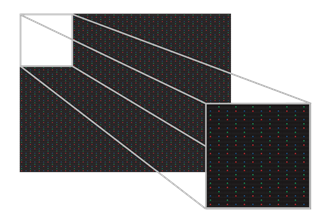Technical Background MAN
Description
Assignments
15m by 2m
3840 by 480 pixels
H264 or H265 compression
4mm picth
Outline
 |
 |
| LED panels installation |
What is a LED?

LEDs come in two different forms. Manufacturers use several types of LEDs to construct digital displays. The two most common are Through-Hole LEDs and Surface Mount Device (SMD) LEDs, also known as Surface Mount Technology (SMT).
|
|
|
What is a Surface Mount Device LED?
Total light emitted isn’t concentrated in a focused area since SMD LEDs do not have directional reflector cups. Instead light disperses evenly across both horizontal and vertical angles, providing wider viewing angles. This makes SMD LEDs an excellent choice for most indoor applications as well as some tighter pitch outdoor applications.

What is a module?
LED modules are made up of parts that form the building blocks of video displays, message centers and dynamic message signs. Rows of modules line together to arrange the LEDs in different variations depending on their product, market and purpose.



Pixel pitch
is the distance from the center of an LED cluster (or pixel) to the center of the next LED cluster/pixel measured in millimeters. Pixel pitch typically ranges from 4mm up to 20mm for indoor LED displays; for outdoor displays, pixel pitch can range from 10mm to 34mm or higher. Pixel pitch directly correlates your display resolution and optimal viewing distance. The smaller the pixel pitch number, the more pixels used to make up the image on your display, thus improving the resolution and optimal viewing distance. The lower the pixel pitch, the closer a viewer can stand to your display and still have a great resolution. Having a smaller pixel pitch does help picture, but at a cost. By having a smaller pixel pitch, one increases the number of LED clusters for a display. A NanoLumens 114″ display with a 4mm pixel pitch uses 247,760 pixels, where as a 6mm LED display of the same size uses 96,000. The more LED clusters in your display, the higher expense.
What is a resolution?
Resolution is the number of pixels contained in the physical area of an electronic display. The higher the number of pixels per square foot, the higher the amount of detailed displayed. Resolution is determined by display size, pixel technology, pixel pitch and viewing distance.
|
|
|
|
What are viewing distances?
Viewing distances are calculated based on the display type and the distance from the display. Each display will have a minimum and a maximum viewing distance that may vary based on application and intended use.

Readings
The following was a feedback from Film Student.
Miscellaneous
W 15m by H 2m
3840 by 480 pixles
4mm pitch
mp4 H264 or H265 compression




